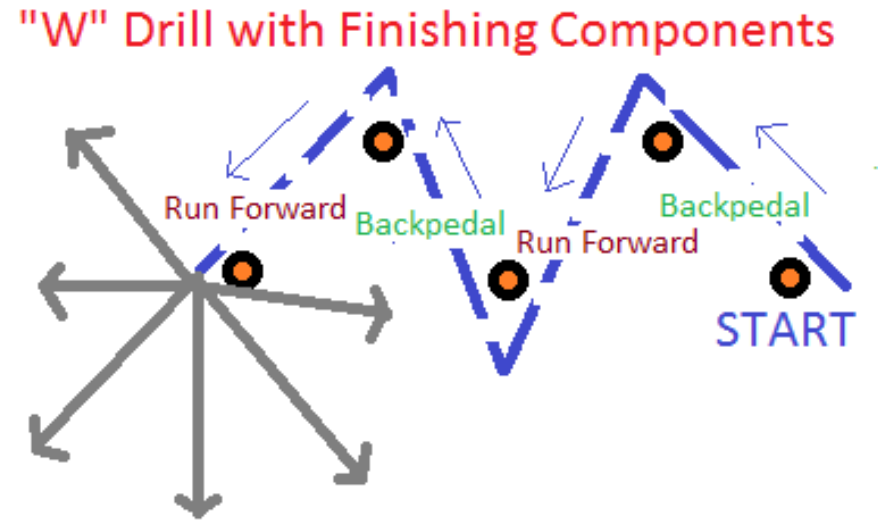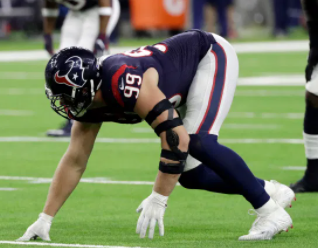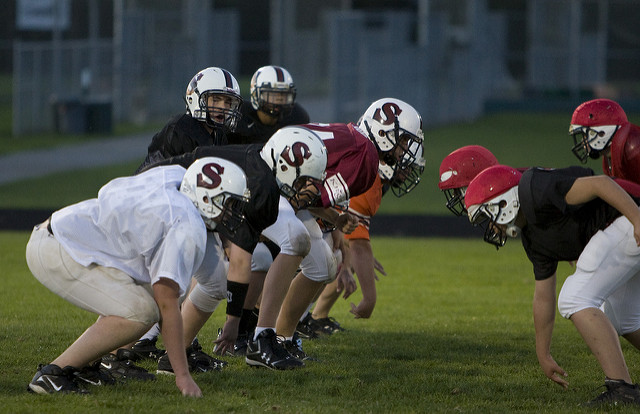When I first started attending coaching clinics I listened to some great speed coaches speak about their football agility drills and strength and conditioning programs and I always felt very overwhelmed.
I always left these clinics believing my program was inadequate since they showed a bunch of drills and exercises that I was not doing.
Over time, I eventually concluded that there are so many agility and plyometric drills and routines that it would be impossible for me to incorporate every good drill I came across.
If that is the case, then how did I decide what to use and what not to use?
I started asking myself questions like if I had a good 135 degree cutting drill, did I need a different one?
The important thing was that my athletes were proficiently performing 135 degree cuts.
To keep things simple for my athletes, I did not want to constantly teach them new drills because then we spent too much time teaching and not enough time working.
Because of that I did a breakdown of all of the movements and actions that my athletes needed to be successful.
My list has grown and changed over the years so I have had to change some of our exercises but now I am changing because we are missing an important component instead of changing just because someone else is doing it differently.
Below is my current list of athletic movement components that need to be programmed to not only teach body movement but to also prepare the athletes for the rigors of practices and games.
My list is never perfect and is always being updated but it at least will get your started on building a comprehensive agility program.
15 Football Agility Drills Components
1. Accelerating And Stopping
All football agility drills should develop the ability to change between accelerating and stopping.
The best athletes are able to stop their body movement quickly so they can move in a different direction.
Program some drills where you have to start and then come to complete and/or partial stops.
Example Video of Full Stops Example Video of Partial Stops
2. Adjusting Body Angles
Proper acceleration and stopping techniques have to be taught to all players since body angles are vitally important in every movement on any playing field.
Teaching proper angles will also transition to plyometrics and strength training.
PROPER ACCELERATION
PROPER STOPPING
3. Cutting At A Variety Of Angles
Drills should integrate 45, 90, 135, and 180 degree cuts. Each drill does not have to incorporate all cuts but your overall program should incorporate all of the cuts. This will allow all athletes to be prepared for the skills that each position requires.
4. Teach Pigeon-Toe Cuts
To efficiently cut in all directions, planting the foot with the toes slightly pointed to the inside will allow the hips to open up quicker and with more range of motion. It also creates less pressure and strain through the hips which will help with injury prevention.
Example WR Video of Pigeon Toe Cuts
5. Adjusting Distances
Changing the distances for an agility drill will completely change each drill. Spreading the cones out further will allow for more acceleration while making it harder to stop. Pushing the cones closer together will eliminate the acceleration patterns but will work more on quickness. If I feel like our kids are tired or I want them to be fresh for a game, I will shorten the distances also.
6. Integrate With Plyometric Drills
You can mix plyometric drills with agility drills so the athletes have to efficiently transition between all athletic movement patterns. You can also do plyometrics in a variety of patterns to simulate agility patterns.
7. Integrate With Reaction Drills
Players can react to pointing to cones, stepping to cones, or verbal directions while performing agility patterns. The best reaction drills are the ones where they have to react to the movement of their opponent so they can improve their blocking and open-field tackling.
8. Integrate With Sport-Specific Skills
Take the agility drills that you are currently doing and add a football component to them. For example and with my Defensive Backs, I had players run through an agility pattern and then end the drill by the players cutting off the final cone and doing a variety of ball drills. This could also be applied to Wide Receivers and their Route Tree.
9. Transition Between Multiple Skills
Players must transition between cutting at different angles, between running and jumping, and running in different directions.
10. Do Drills While Moving Backwards
Most people only do agility drills moving forward. That is a problem since our defensive backs backpedal constantly and our offensive lineman go backwards in their pass sets. One way to work on being agile while moving backward is to do ladder drills while moving backward instead of forward.
11. Do At The Beginning Of workouts
If you want to work on pure speed and quickness, then do your agility workouts at the beginning of your workout before your players get tired. That being said, from time to time put your agility workouts at the end of the workout so your players can get better at being explosive while tired.
12. Make It Competitive!!
Competition brings out the best in all athletes. Always have at least 2 players competing to ensure there is always a winner and a loser.
13. Play Games
A well-crafted game will make players more agile without them knowing that they are working on their agility. An example of a great game is playing Dodgeball without a center line. The players will chase each other all over the field and can make point-blank throws. I usually set the boundaries as the sidelines and then from the goal line to the 50 yard line. When a team wins they then turn on each other so we always have just one winner.
14. Easy To Advanced
Start off with easy concepts so every cut can be properly taught and players can concentrate on certain techniques. As players get better at drills, give them more complex patterns with other things mixed-in like plyometrics, reaction, etc. At the beginning of the next sports’ season, start with the easy patterns again so the players who were in other sports can learn the proper technique. The review is good for everyone.
15. Rest And Recovery
If you want to work pure speed, then either give them 1 minute rest for every 10 yards or 15 seconds rest for every 1 second that is needed to complete your football agility drills.
Just make sure that you think about what you are trying to accomplish for that day and that drill. Some days a program should give maximum rest and other days the athletes should be required to proficiently complete drills while tired.
Here is an example weekly breakdown that I have made to make sure all 15 components have been incorporated:
If you are interested in learning more you can go to the resources page on my website (https://exceleratead.com/training-theory) to find my FREE and moderately priced CoachTube Courses, Coaches Choice Videos, and a variety of other training articles and resources. My contact information is on my website so please feel free to email me with any questions.
Adam Szabo
Owner, Excelerate Athletic Development, LLC





